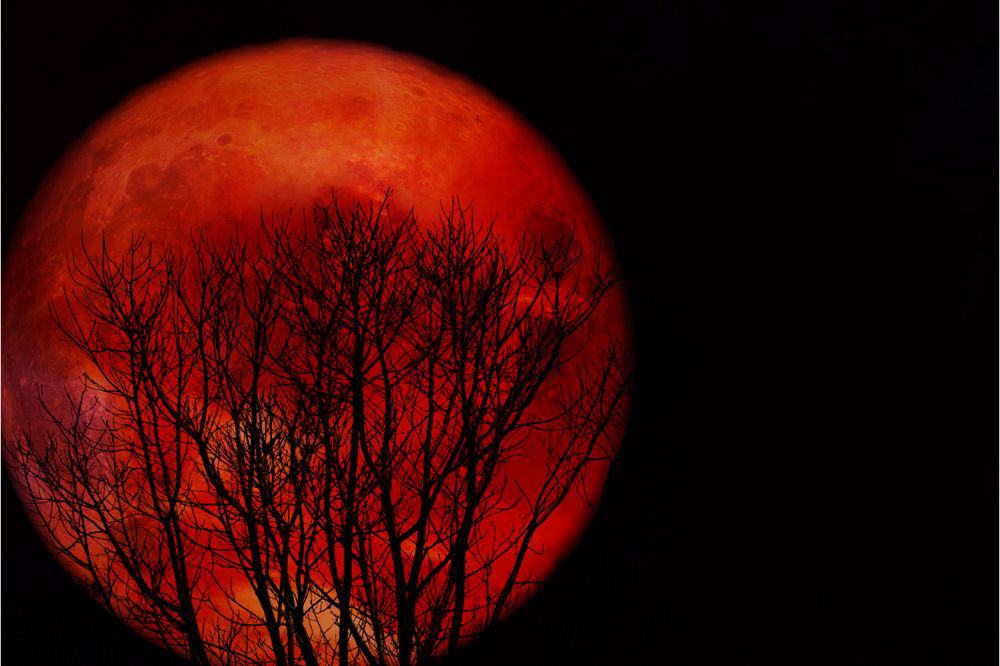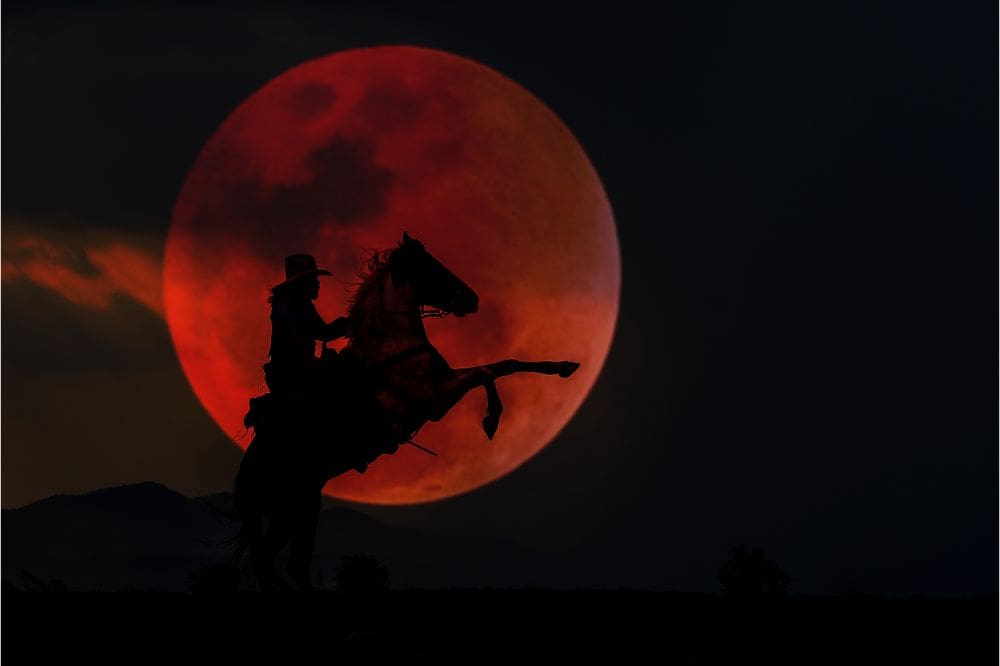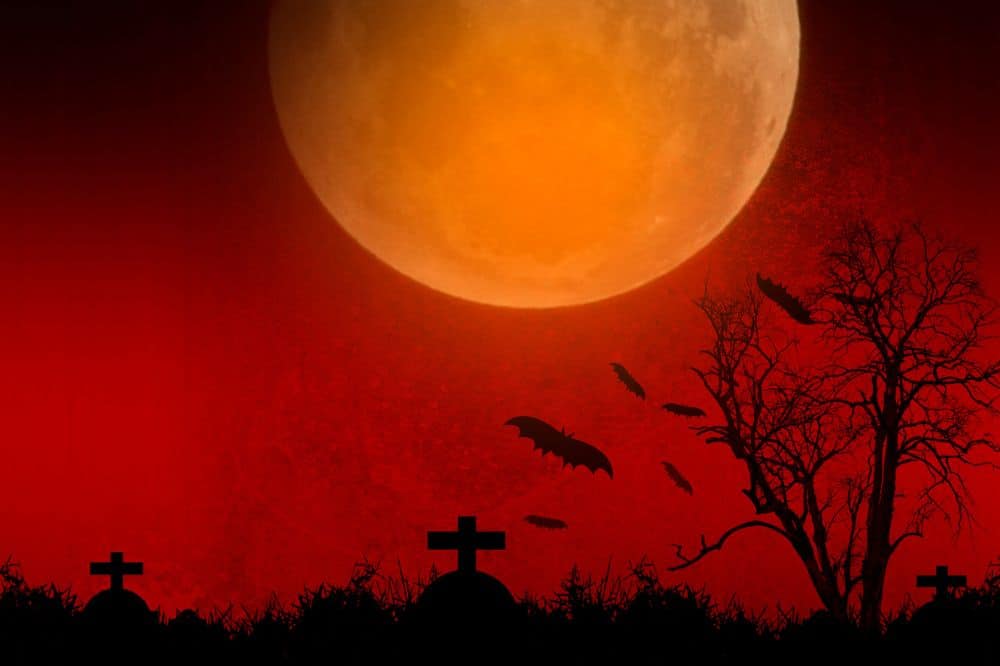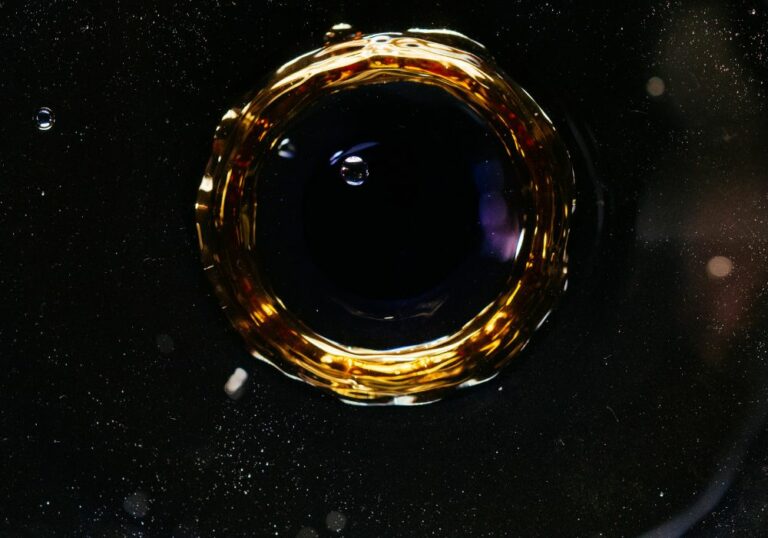Have you ever seen the movie, “Bewitched”? If so, you might remember Nicola Kidman’s character looking up at the sky in dismay. “Blood on the moon!” she cries in horror, pointing to a rosy orb.
But what exactly is a blood moon? And does it carry any spiritual significance?
That’s what we’re here to find out. We’re going to explore what a blood moon is, and what causes it. And we’ll find out what it’s symbolized to different cultures through the ages.
So if you’re ready, read on to find out more about the spiritual meanings of a blood moon.
Spiritual Meanings of Blood Moon
What is a Blood Moon?
The term blood moon is actually used to describe a number of different events.
Strictly speaking, a blood moon occurs when there is a total lunar eclipse. That takes place when the moon, the Earth and the sun are all aligned. The Earth prevents the light of the sun from reaching the moon.
Rather than the bright white or golden light of the sun on the moon’s surface, there’s a red glow. That’s because the only light that can reach the moon is that which is filtered through the Earth’s atmosphere.
Particles in our atmosphere scatter the light, and blue light scatters more widely than red. So when we look at the moon, it appears a rosy shade. It’s not quite the rich red you might expect from the term “blood moon”! But it’s still distinctly ruddy.
Blood moons of this kind are a relatively rare event. A full lunar eclipse takes place only about twice every three years. Added to that, what appears as a blood moon when viewed from one place may not look the same from another.
There are, however, occasions other than a lunar eclipse when the moon can look red. If there’s a lot of dust or haze in our own sky, that can filter out the blue light too. The result is a moon that glows with a redder light.
And some people even refer to a blood moon when it’s actually a perfectly normal color! This usually occurs during the Fall. That’s when the leaves on many deciduous species of trees turn a rich red. If you see the moon through the branches of such a tree, it can be referred to as a blood moon.
The Blood Moon Prophecy
We’ve already seen that there’s a scientific explanation for what causes a blood moon. But does its striking appearance also carry any deeper meaning?
Some people believe that it does. And in 2013, two protestant American preachers cited what became known as the “Blood Moon Prophecy”.
The occasion was an unusual astronomical event – a series of four full lunar eclipses taking place between two years. This is known as a tetrad.
The tetrad that was the subject of the Blood Moon Prophecy took place between April 2014 and September 2015. And it had some other unusual features too.
Each of the eclipses fell on a Jewish holiday, and there were six full moons in between them. None of these involved a partial eclipse.
As we know, it’s common for the moon to appear red during a total lunar eclipse. That’s just what happened here. And the moon on the final eclipse, on 28 September 2015, was particularly striking in its red color.
The two preachers, Mark Blitz and John Hagee, claimed that these events were linked to the Apocalypse foretold in the Bible. They pointed to passages in the Biblical books of Joel and Revelation to support their theory.
Hagee went on to write a bestselling book on the connections he saw. While it didn’t foretell any specific apocalyptic events, it linked tetrads through time with calamities in Jewish or Israeli history.
Blood Moons in the Bible
There are several instances where blood moons are referred to in the Bible.
In the Book of Joel, there is a reference to the sun becoming dark and the moon turning into blood. These events, it said, would take place before the “great and terrible day of the Lord”.
The disciple Peter repeats the prophecy in the Book of the Acts of the Apostles. But Peter said that the prophecy had been fulfilled by Pentecost, rather than relating to events in the distant future. (Pentecost was when the Holy Spirit descended to the disciples after Jesus’s death.)
The final reference to a blood moon comes in the ever-kooky Book of Revelation. This states that on the opening of the “sixth seal”, the sun will turn black, and the moon will be “as blood”.
It’s perhaps not surprising, then, that some people view a blood moon as a bad omen.
Blood Moons as Ill Omens
The link between eclipses and the end of the world also appears in the Islamic faith.
Islamic texts state the moon will be eclipsed, and the sun and moon will join together on Judgement Day. And some Muslims say special prayers during a eclipse, acknowledging Allah’s power over the heavens.
In Hindu scriptures, the eclipse is depicted as the revenge of a demon called Rahu. Rahu had drunk an elixir that made him immortal, but the sun and moon cut off his head.
Of course, decapitation isn’t enough to get rid of an immortal! Rahu’s head still pursues both the moon and the sun to take vengeance. Sometimes he catches and eats them, before they reappear through his severed neck. Hence the explanation for a lunar or solar eclipse.
In India today, the blood moon continues to be associated with ill fortune. Food and drink is covered when one occurs, to avoid it becoming contaminated.
Expectant mothers are considered to be particularly at risk. It’s believed they should not eat, drink or carry out household chores during the blood moon.
People in other parts of the world also see a blood moon as a bad omen. An old wives’ tale from the British Isles holds that you should not point at a blood moon. It’s bad luck. And it’s even worse if you point at the moon nine times!
As late as the 1950s, a superstition persisted in Europe that hanging out babies’ nappies to dry under a blood moon would attract bad luck.
Blood Moons in Ancient Cultures
Ancient cultures also saw a link between the blood moon and dramatic events.
For the Incans, it occurred when the jaguar ate the moon. They feared that when the beast had finished with the moon, it would attack the earth. It’s believed they responded by making as much noise as possible in an attempt to frighten the jaguar away.
The idea that an eclipse was a sign of the moon being eaten also appeared in many other cultures. The ancient Chinese believed that the culprit was a dragon. And the Vikings believed that wolves who lived in the sky were responsible.
The ancient Babylonians – living in the region between the Tigris and the Euphrates rivers – also feared the blood moon. For them, it augured an attack on the king.
Fortunately, their advanced astronomical skills meant they could predict when a full lunar eclipse would occur.
To safeguard the monarch, a proxy king was put in place for the duration of the eclipse. The unfortunate stand-in was disposed of when the eclipse was over. The royal throne, table, scepter and weapon were burned too. The rightful monarch then resumed the throne.
Positive Interpretations of Blood Moons
So far the message behind a blood moon generally seems to be pretty negative. But that’s not the case everywhere.
The ancient Celts associated lunar eclipses with fertility. They revered the moon, and rarely referred to it directly. Instead, they used words like “gealach”, which means “brightness”, as a mark of respect.
This custom persisted on the Isle of Man, off the coast of Britain, until recent times. Fishermen there used the phrase “Ben-rein Nyhoie”, meaning “Queen of the night” to refer to the moon.
Different Native American tribes have different beliefs around the blood moon. For the Luiseño and Hupa peoples of California, it signifies that the moon is wounded, and requires care and healing. The Luiseño tribe would chant and sing to the moon to help it recover.
For other tribes, the eclipse is a sign of change to come. The moon, it is believed, controls life on earth. An eclipse disrupts this control, meaning things will be different in future.
In Africa, the Battamaliba people of Benin and Togo believed the eclipse was a battle between the sun and moon. To encourage them to resolve their differences, they set a good example by putting their own disputes to bed.
And in Tibet, Buddhists believe that any good deeds carried out under a blood moon will be multiplied. The same goes for anything bad you do too, though – so take care!
Wiccans see the harvest moon – a blood moon in October – as an auspicious occasion. They believe its appearance means it’s a good time to embark on new endeavors and creative projects. And it’s also a time to get rid of any negative habits that are holding you back.
What Does the Science Say?
With so many superstitions surrounding the blood moon and full moon, researchers have taken a closer look.
One of the common beliefs is that full moons affect people’s behavior. This idea lies behind terms like “lunacy”, with lunar referring to the moon. And many horror stories feature werewolves, people who turn into ferocious wolves when the moon is full.
You might not be surprised to hear that there’s no scientific evidence for the existence of werewolves! But research has also found no basis for the other widespread beliefs about human behavior changing under a full moon.
And in other good news, the claim that blood moons are responsible for earthquakes has been debunked too. The US Geological Survey looked at the relationship between the type of moon and incidence of earthquakes. The result? There wasn’t any.
But that’s not the whole story. A study by researchers in Japan looked at the strength of earthquakes during different phases of the moon. They found that an earthquake occurring when there was a blood moon was on average slightly stronger.
Finding Your Own Spiritual Meanings in the Blood Moon
As we’ve seen, blood moons have carried different symbolism at different times and in different places. So how do you go about interpreting its significance to your own spiritual journey?
The first step is to realize that any meaning is personal to you. Other people’s interpretations can be interesting, but their messages may not resonate with your own circumstances. Taking the time for meditation and inward reflection is essential to getting in touch with your own spirituality.
Some people find that the moon itself can provide focus for such meditation. And some find that full moons in particular are a good time to reflect.
A blood moon can help give focus to exploring unacknowledged thoughts and feelings. It can be seen as an invitation to reflect on darker emotions, such as anger, regret, grief or shame.
This spiritual work can allow us to find meaning and learning in emotions we sometimes see as negative. Opening ourselves to those emotions and exploring the reasons behind them can also make it easier to let them go.
Some people find it helps to write down those feelings and destroy the paper on a full moon. Others repeat affirmations – particular phrases – to instil positive beliefs, particularly in relation to self-esteem.
The Moon as a Spiritual Guide
That brings us to the end of our look at the spiritual meaning of blood moons.
The science behind the phenomenon is clear. While legends of ravening jaguars, disobedient demons and hungry dragons may be entertaining, we know they’re not the real cause of blood moons.
But for many people, their relationship with the moon transcends science. A blood moon is a stunning natural phenomenon that can inspire awe and wonder. And that can be a great basis for taking time out for meditation and introspection.
We hope that enables you to find meaning in the blood moon for your own spiritual journey.










